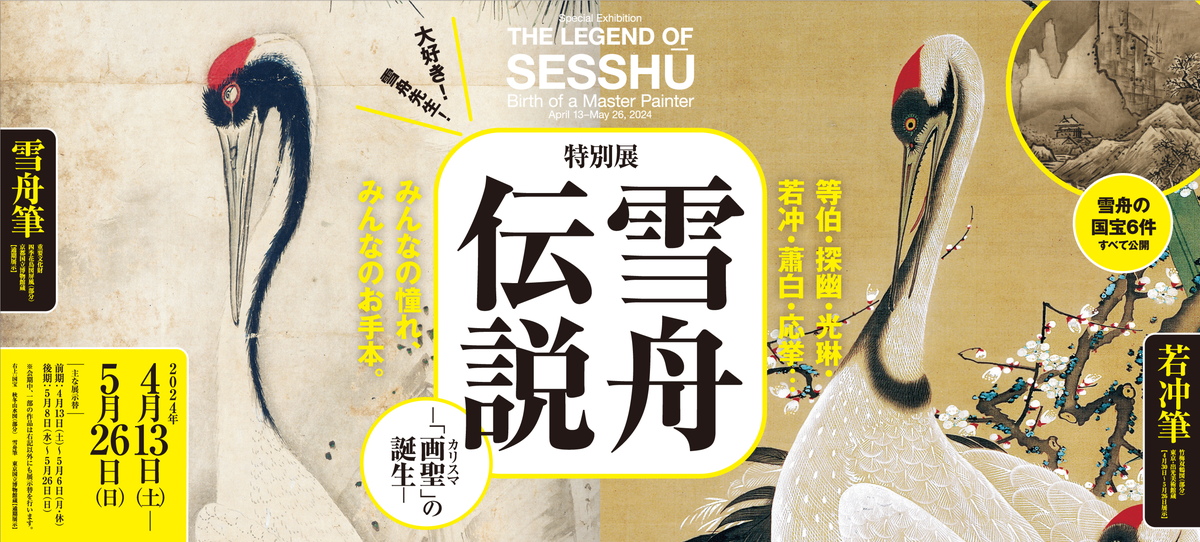- TOP
- Exhibitions
- Special Exhibitions
- Special Exhibition The Legend of Sesshū: Birth of a Master Painter
General Information
Advanced ticket reservations for this exhibition are not required. However, in order to alleviate congestion in the galleries, the number of people allowed into the galleries may be limited.
- Exhibition Title
-
Special Exhibition
The Legend of Sesshū: Birth of a Master Painter
- Period
-
April 13–May 26, 2024
The exhibition has two installations:
Part I: April 13–May 6, 2024
Part II: May 8–26, 2024
Some artworks may be rotated during the exhibition period.
- Venue
-
Kyoto National Museum, Heisei Chishinkan Wing
- Closed
-
Mondays
*In 2024, the museum will remain open from Monday, April 29 through Monday, May 6. On Tuesday, May 7, the museum will be closed.
- Special Exhibition Hours
-
9:00 a.m.–5:30 p.m. (entrance until 5:00 p.m.)
- Special Exhibition Admission
-
Adult 1,800 yen
(1,600 yen)University Student 1,200 yen
(1,000 yen)High School Student 700 yen
(500 yen)- The discounted prices in parentheses ( ) are advance ticket and group ticket rates.
- Group ticket rates apply to groups of 20 people or more.
- Advance tickets will be on sale between February 13 and April 12 at major ticket outlets and other locations.
- See the official exhibition website (in Japanese only) for information about advance tickets, discount advance tickets, and advance tickets with original exhibition goods.
- Please show student ID for student admission.
- Admission is free for junior high school students and other youths age 0–15, as well as for visitors with disabilities and one caretaker. Please show ID.
- Admission is reduced by 500 yen for Campus Members (including faculty) able to produce ID (applicable only to the purchase of same-day tickets at the South Gate ticket office).
- Audio Guide
-
Venue Rental Edition
- Fee
- 650 yen (includes tax)
- Duration
- Approx. 35 min
- Languages
- Japanese, English
- Rental Hours
- 9:00 a.m.–5:00 p.m. (return by 5:30 p.m.)
App Edition
- Fee
- 800 yen (includes tax)
- Languages
- Japanese
- Period of Availability
- Early April through the end of May, 2024 (planned)
- Catalogue
-
For availability and purchasing information, see Exhibition Catalogues and Related Publications
- Organized by
-
Kyoto National Museum, Nikkei Inc., TV Osaka, Kyoto Shimbun
- With the support of
-
Iwatani Corporation; Social Welfare Corporation AKATSUKIKAI; Nissha Co., Ltd.
- In conjunction with
-
FM Osaka Broadcasting Co., Ltd.; FM-Kyoto Inc.
- Special Exhibition Official Website
-
- The official exhibition website is no longer in service.
Description of Exhibition
Sesshū (1420–1506?) is widely acknowledged to be one of the most pivotal figures in the history of Japanese art. The fact that an unprecedented six of his paintings have been designated National Treasures underscores the profound admiration he commands in modern Japan. Yet, this recognition is not based solely upon the excellence of his artworks; it also stems from the ways in which Sesshū’s reputation evolved over time.
This exhibition traces perceptions of Sesshū during the early modern period (late sixteenth through late nineteenth century) to examine how the enduring reverence for this “saint of painting” was shaped. During the Momoyama period (1573–1615), the Unkoku and Hasegawa schools proudly identified themselves as artistic successors of Sesshū. In the Edo period (1615–1868), artists of the preeminent Kano school eagerly integrated Sesshū’s techniques into the very foundation of their own signature painting style. Sesshū’s artistic charisma inspired not only these major schools of Chinese-influenced ink painting (kanga), but also influenced a diverse range of painters working outside these traditions, who learned from Sesshū’s works in order to chart new frontiers in Japanese painting.
Conceptualizing the reception of Sesshū’s legacy is inherently complex and requires a nuanced understanding that synthesizes multiple perspectives. Through an exploration of the manifold ways in which Sesshū was perceived and interpreted over time, this exhibition seeks to shed light on the intricate journey that culminated in Sesshū’s emergence as a legendary “saint of painting.”
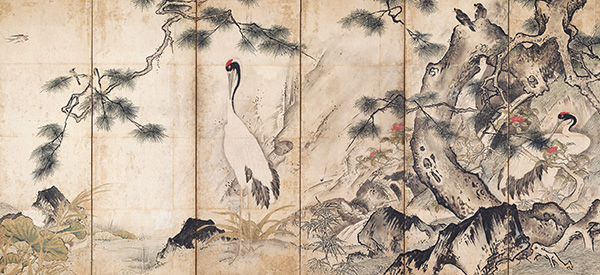
Important Cultural Property
Birds and Flowers of the Four Seasons (right screen)
By Sesshū Tōyō
Kyoto National Museum
Section 1 Sesshū’s Essential Masterworks
Numerous paintings are ascribed to Sesshū, yet there has not been a consistent consensus on which are unquestionably authentic. In this section, we begin by examining works regarded as Sesshū’s genuine masterpieces, embodying his status as a “saint of painting” (gasei). Sesshū’s renown did not evolve in isolation; it was founded on the existence of such exceptional artworks. More recently, the designation of these paintings as National Treasures and Important Cultural Properties underscores the enduring reverence for Sesshū in modern Japan.
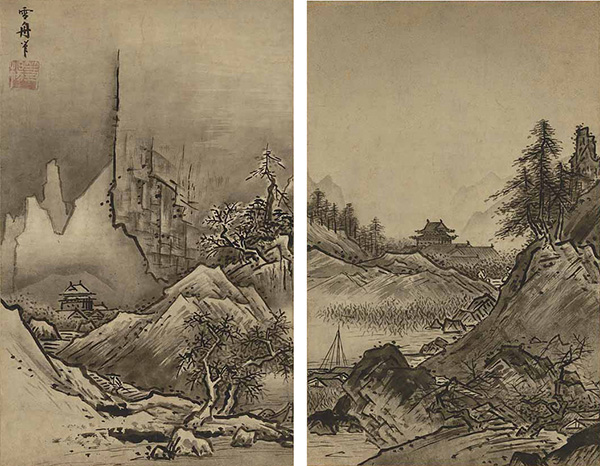
National Treasure
Autumn and Winter
Landscapes
By Sesshū Tōyō
Tokyo National Museum
Section 2 Exemplary Sesshū
The ability to compile a list of authentic masterworks by Sesshū is feasible only in our contemporary age. During the Edo period (1615–1868), many such works were kept in secrecy and were neither easily accessible nor knowable. In this section, we introduce works associated with Sesshū that were widely known in later centuries and consequently had significant influence. While some of these paintings are no longer considered to be by Sesshū himself, they nevertheless help deepen our understanding of the artist’s impact in early modern Japan, revealing how Sesshū’s painting themes and brushwork styles were inherited by future generations.
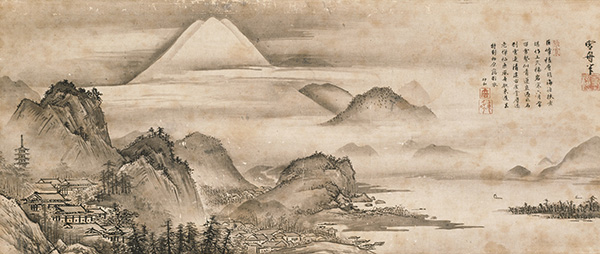
Mount Fuji, Miho no Matsubara, and Seiken-ji Temple
Attributed to Sesshū Tōyō, inscription by Zhan Zhonghe
Eisei Bunko Museum, Tokyo
Section 3 Sesshū’s Artistic Legacy: The Unkoku and Hasegawa Schools
Although Sesshū nurtured many disciples, including Shūgetsu, Sōen, and Tōshun, his direct lineage did not last particularly long. The task of inheriting and revitalizing Sesshū’s artistic legacy fell to later artists such as Unkoku Tōgan (1547–1618) and Hasegawa Tōhaku (1539–1610), who flourished during the Momoyama period (1573–1615). While not direct disciples of Sesshū, they proclaimed themselves to be his successors, producing numerous works emulating Sesshū’s painting style. Anecdotes even circulated during the Edo period (1615–1868) about the rivalry between these two figures, both of whom claimed to be rightful heirs to the Sesshū lineage.

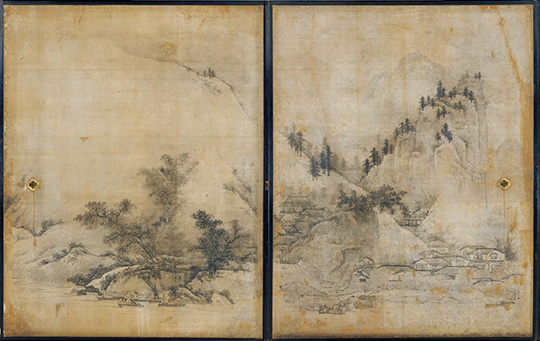
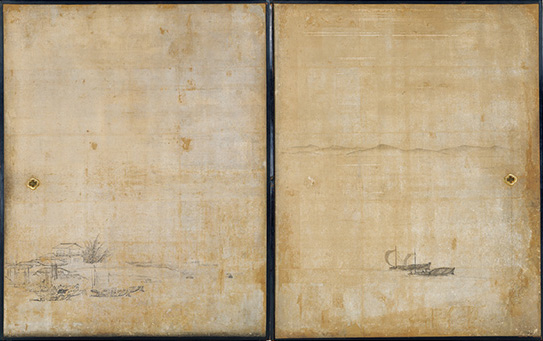
Important Cultural Property
Landscape
By Unkoku Tōgan
Ōbai-in Temple, Kyoto
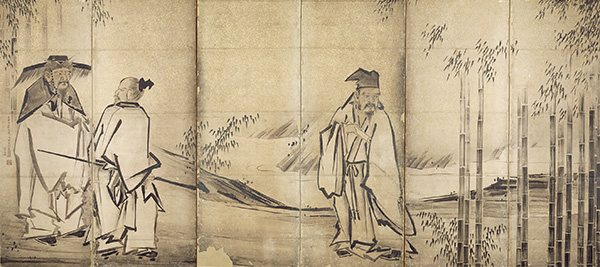
Seven Sages of the
Bamboo Grove (left screen)
By Hasegawa Tōhaku
Ryōsoku-in Temple, Kyoto
Section 4 Birth of the Sesshū Legend: The Key Role of the Kano School
The figure who played the most significant role in the Sesshū’s deification in early modern Japan was Kano Tan’yū (1602–1674). Tan’yū’s painting style became not only a common foundation for Kano-school artists but also a shared basis for Edo-period painting as a whole. In shaping his distinctive artistic approach, Tan’yū borrowed extensively from Sesshū’s legacy. In this section, we observe how Sesshū’s themes and painting styles were perpetuated through the works of Kano school artists, especially Tan’yū, during the Edo period (1615–1868).
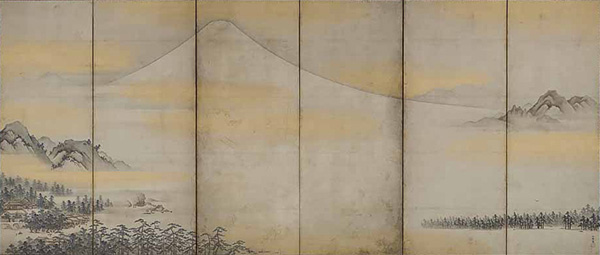
Mount Fuji, Miho no Matsubara, and Seiken-ji Temple
By Kano Sansetsu
Section 5 Emulating Sesshū ㏌ the Edo Period
During the Edo period (1615–1868), there were many more “Sesshū paintings” in circulation than there are today. Not all of these were genuine. Some have since been deemed inauthentic; others have gone missing. Nevertheless, these works were once accepted as part of Sesshū’s oeuvre and contributed to the formation of his image. In this section, we look at small sketches (shukuzu) and copies (mohon) by Kano school painters in order to explore how those in Edo-period Japan may have comprehended paintings they believed to be by Sesshū.
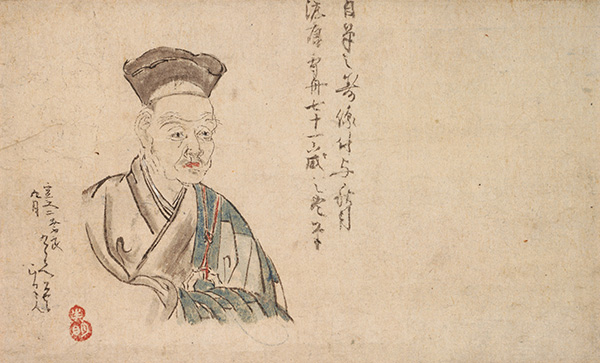
Copy of Portrait of Sesshū, from Small Sketches by Tan’yū
By Kano Tan’yū
Kyoto National Museum
Section 6 Articulating Sesshū
Sesshū’s influence was disseminated not only through the inherent power of his artworks but also through the words and descriptions of various individuals as they discussed the artist. The role of publications was crucial in circulating information about Sesshū, including the visual iconography of his artworks. How was Sesshū talked about during the Edo period (1615–1868)? In this section, we focus on woodblock-printed books, letters, and other textual resources in order to provide a glimpse into the discourse surrounding this master artist.

Letter from Ogata Kōrin to Ueshima Gennojō
By Ogata Kōrin
The Museum Yamato Bunkakan, Nara
Section 7 The Broadening and Diversification of Sesshū’s Reception
The deification of Sesshū was not solely the work of the Kano school. Sesshū was also revered by other painters dedicated to Chinese Song- and Yuan-influenced painting styles (kanga), such as those of the Unkoku and Hasegawa schools. Additionally, Sesshū’s works were emulated in manifold ways by a much wider range of Edo-period painters. Particularly from the eighteenth century onward, perceptions of Sesshū greatly expanded and diversified, unquestionably contributing to his current standing as a “saint of painting.”
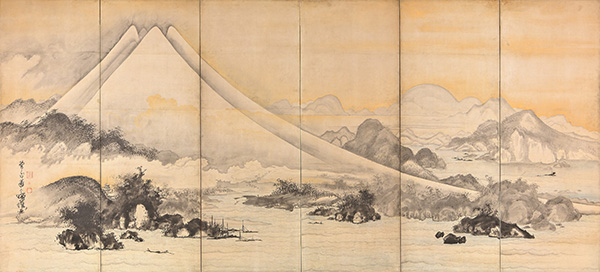
Mount Fuji and Miho no
Matsubara (left screen)
By Soga Shōhaku
Miho Museum, Shiga
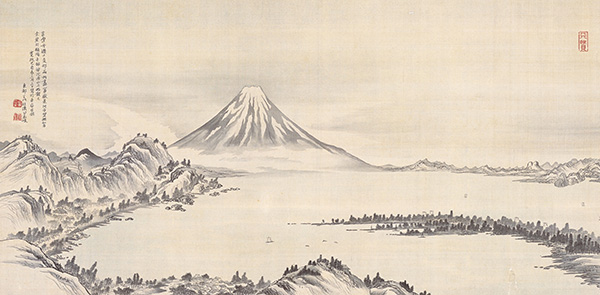
Mount Fuji Viewed from Yabe in Suruga
By Shiba Kōkan




